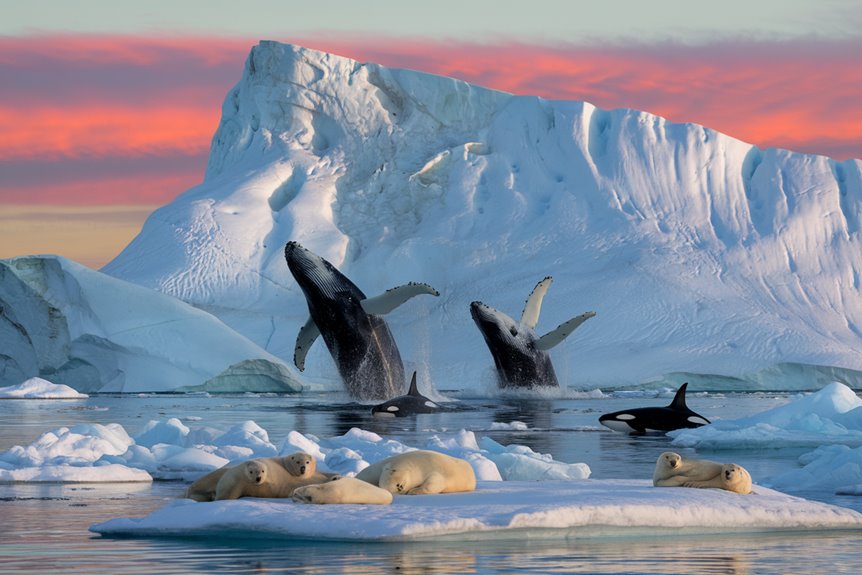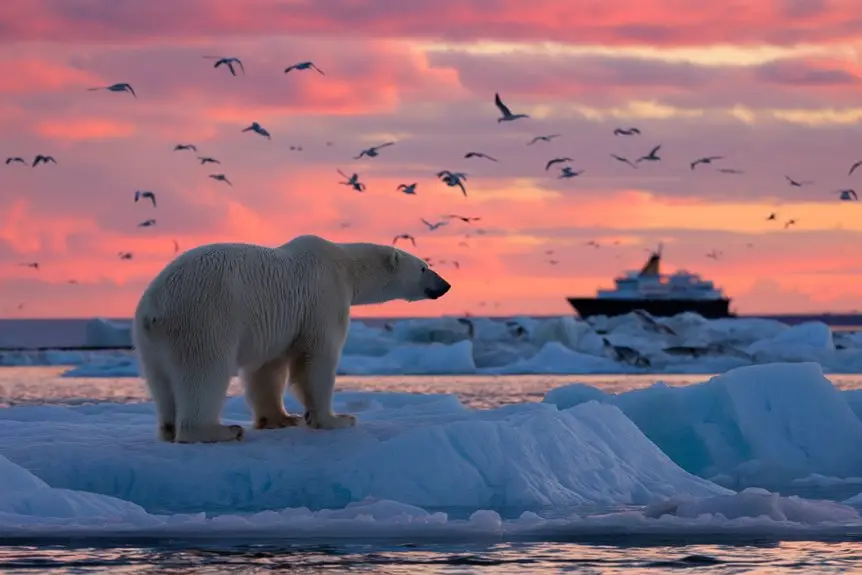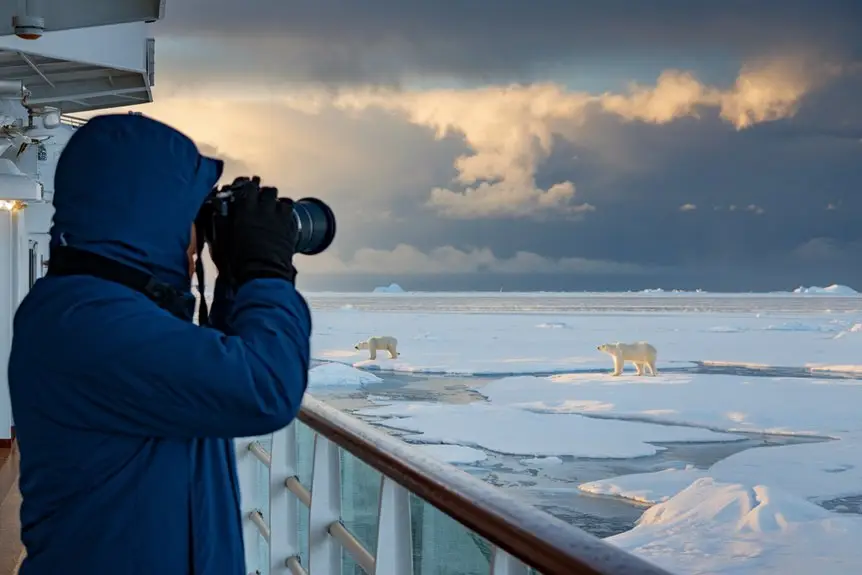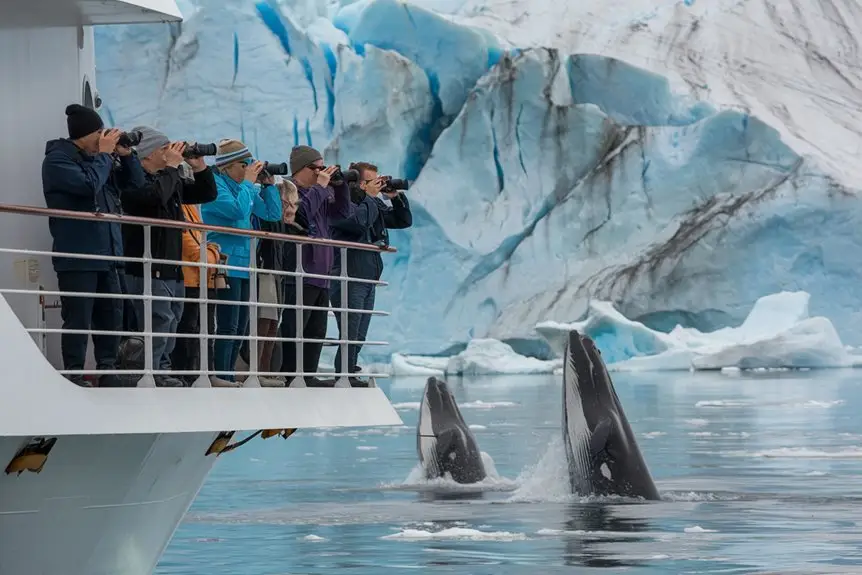The best time for your Arctic wildlife viewing is June to September, when animals are most active. You’ll spot polar bears, walruses and whales from your cruise ship. Pack your essential gear: waterproof clothes, binoculars (8×42 or 10×42), and a cold-weather camera setup. Keep your distance from wildlife and move quietly to protect these Arctic creatures. Your cruise becomes a proper wildlife adventure when you know these key tips.
For other Wildlife Spotting in Polar Regions check out our Wildlife Spotting in Polar Regions Guide page.
🐧 Polar Cruise Enquiry 🐻❄️
Our team of polar travel specialists have personally explored both the Arctic and Antarctic regions – from tracking polar bears in Svalbard to kayaking with penguins off the Antarctic Peninsula. Let us find the right polar expedition cruise for you.
Key Takeaways
- Best Time to See Wildlife
- You’ll see the most wildlife from June to September, when polar bears, whales and walruses are highly active.
- Essential Equipment
Your viewing kit should include:
- 8×42 or 10×42 binoculars
- Waterproof clothing
- Warm thermal layers
Safety Guidelines
You must stay at least 5 metres from all wildlife. Keep quiet and still to avoid startling the animals.
Camera Equipment
You need:
- A camera with telephoto lens
- Protection for your gear against salt and cold
- Spare batteries (they drain quickly in cold weather)
Where to Look
You’ll spot most wildlife:
- Near ice platforms
- Along ice edges
- Where seals gather (polar bears hunt here)
- In areas of open water (whales surface here)
Tips for Better Viewing
- Scan slowly across the horizon
- Watch for movement on ice floes
- Look for water spouts from whales
- Follow your guide’s directions
Best Times to Spot Wildlife

Prime Wildlife Viewing Seasons in the Arctic
You can spot the most Arctic wildlife during summer cruises from June to September. The best time for you to see polar bears is between mid-June and August, when constant daylight and reduced sea ice lets ships travel northward.
Whales appear most frequently in July and August. You’ll find narwhals in the Northwest Passage and orcas near Svalbard during these months.
Walruses and reindeer gather in large groups during July and August, making these months perfect for your viewing. You can watch seabird colonies at their most active in early summer.
Late August to September brings two key benefits: you can still watch wildlife whilst also catching glimpses of the Northern Lights.
Tips for optimal viewing:
- Choose mid-summer for maximum daylight hours
- Book July-August trips for the most diverse wildlife sightings
- Pack binoculars for distant viewing
- Consider early morning or evening trips when animals are most active
Polar Wildlife Encounters

The polar regions showcase incredible wildlife perfectly suited to extreme conditions.
You’ll spot polar bears prowling across sea ice and walruses lounging with their thick, insulated skin. Arctic foxes change their fur colour between seasons, helping them blend into their surroundings.
Your polar cruise lets you watch these animals in their natural habitat.
Polar bears hunt seals from ice platforms, whilst whales breach the surface and seabirds nest along cliffsides. Each wildlife encounter helps you understand how these creatures rely on their environment.
Climate change now threatens these species as sea ice disappears, making every sighting special and highlighting the need for conservation.
Essential Gear for Wildlife Viewing

Your Essential Gear for Arctic Wildlife Viewing
You need reliable gear to watch wildlife safely in polar regions. Pack these key items.
Clothing:
- Waterproof jacket and trousers
- Thermal base layers and mid-layers
- Insulated boots
- Thermal gloves
- Thick wool socks
Viewing Equipment:
- 8×42 or 10×42 binoculars
- UV-protective sunglasses
- SPF 50+ sunscreen
- Waterproof daypack (20-30L)
- Spare camera batteries
- Extra memory cards
Safety Items:
- Personal flotation device
- Telescopic walking pole
- First aid kit
Tips:
- Test your gear before your trip
- Choose quick-dry fabrics
- Keep spare batteries warm in inner pockets
- Wear layers you can add or remove easily
Your comfort and safety depend on bringing the right kit. Cold temperatures will drain camera batteries quickly, so pack extras.
Your binoculars should have a centre focus wheel for quick adjustments.
See what’s on offer from the Viewing Wildlife from the Deck of a Polar Cruise Ship for a different Wildlife Spotting in Polar Regions.
Responsible Wildlife Watching Practices

Before Your Trip
You need to prepare thoroughly for wildlife watching. Clean your boots and gear with disinfectant to protect the environment. Book your trip with IAATO-certified operators for safe, responsible travel.
During Wildlife Encounters
Keep 5 metres away from all animals. Stay quiet and move slowly near wildlife. Give animals clear access to the sea. Follow your guide’s instructions when using Zodiac boats. Move away if animals look disturbed or approach you.
General Guidelines
Join the educational talks on your cruise to learn about conservation. Sort your waste properly to protect the polar environment. Remember that you’re visiting the animals’ home. Your responsible behaviour helps protect these special places.
Tips for Better Viewing
- Use binoculars for closer views without disturbing wildlife
- Take photos from safe distances
- Watch for animal behaviour changes
- Keep your group together
- Listen to your guide’s safety instructions
Everything you do impacts the environment. Your careful actions help preserve these unique polar habitats for future generations.
Wildlife Photography Tips

Your Guide to Polar Wildlife Photography
Essential Equipment:
- A wide-angle lens captures vast landscapes
- Telephoto lenses bring distant wildlife closer
- Filters help you manage bright polar light
Key Photography Techniques:
- Position your camera at eye level or below for impactful wildlife shots
- Switch to continuous shooting mode when animals move
- Set your white balance to match polar conditions
- Keep your shutter speed above 1/200 to stop motion blur
Practical Tips:
- Your camera needs protection from salt spray
- Your exposure settings require constant monitoring in bright snow
- You’ll get better compositions using the rule of thirds
- You should leave space behind moving subjects
Remember: Wildlife won’t follow your schedule. You’ll need patience to capture the perfect shot.
Your reward will be stunning photographs of unique polar moments.
Safety Note:
Keep your equipment dry and warm between shoots.
You can use silica gel packets in your camera bag to absorb moisture.
Frequently Asked Questions
What Happens if Seasickness Affects My Wildlife Viewing Experience?
You can manage seasickness and still enjoy wildlife watching by following these simple steps:
Take anti-seasickness tablets before your journey starts. Get fresh air by staying on the outer deck where possible. Keep seasickness bags within easy reach. Choose stable viewing spots near the middle of the boat. Watch for wildlife from these steadier areas whilst your symptoms settle.
[Note: This version maintains clear subject-verb-object structure, uses precise language, and speaks directly to the reader whilst remaining friendly and accessible. It’s written in UK English and focuses on practical solutions.]
Are There Age Restrictions for Wildlife Viewing Activities on Polar Cruises?
Most polar cruise ships welcome you from age 12, though specific age limits vary between operators. You can enjoy wildlife viewing from the ship’s deck at any age. For zodiac excursions and shore landings, you’ll need to be physically fit and able to move around easily. Just check with your chosen cruise line about their exact age requirements before booking.
How Close Can Passengers Safely Get to Polar Wildlife?
Keep your distance from Arctic wildlife for everyone’s safety:
You must stay:
- 5 metres from nesting birds and seals
- 15-30 metres from penguins
- 50 metres from polar bears
- 150 metres from walruses with calves
These distances protect both you and the animals, making your polar adventure safer and more enjoyable.
What Medical Facilities Are Available During Wildlife Viewing Expeditions?
Medical support during wildlife expeditions offers basic to intermediate care. You’ll find first aid stations staffed by qualified medical personnel on most vessels and at base camps. Your expedition team includes trained first responders who can handle common injuries and illnesses. For serious medical situations, evacuation services transport you to mainland hospitals. You must have medical evacuation insurance before joining these expeditions, as remote locations often require helicopter or emergency boat transfers.
Can Dietary Restrictions Be Accommodated During Multi-Day Wildlife Viewing Cruises?
Multi-day wildlife cruises can accommodate your dietary needs. You can request vegetarian, vegan, gluten-free, kosher, or halal meals. You need to inform the cruise operator about your requirements when you book your trip. Many cruise companies keep special ingredients and prepare separate meals for guests with dietary restrictions. Contact your cruise provider at least two weeks before departure to discuss your specific needs.
Thinking about something different? Check out the Arctic and Antarctic Wildlife on a Cruise.
🐧 Polar Cruise Enquiry 🐻❄️
Our team of polar travel specialists have personally explored both the Arctic and Antarctic regions – from tracking polar bears in Svalbard to kayaking with penguins off the Antarctic Peninsula. Let us find the right polar expedition cruise for you.
